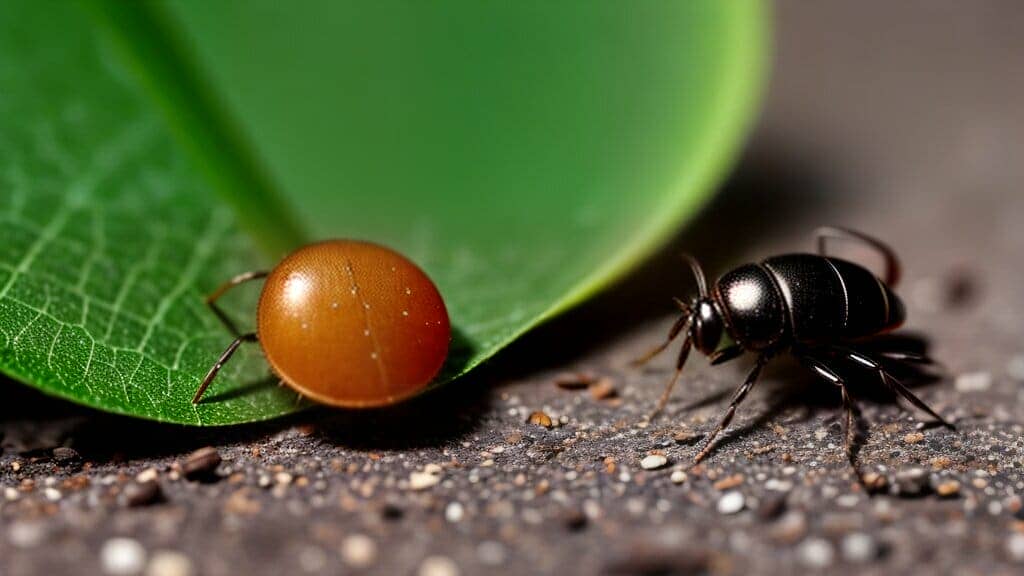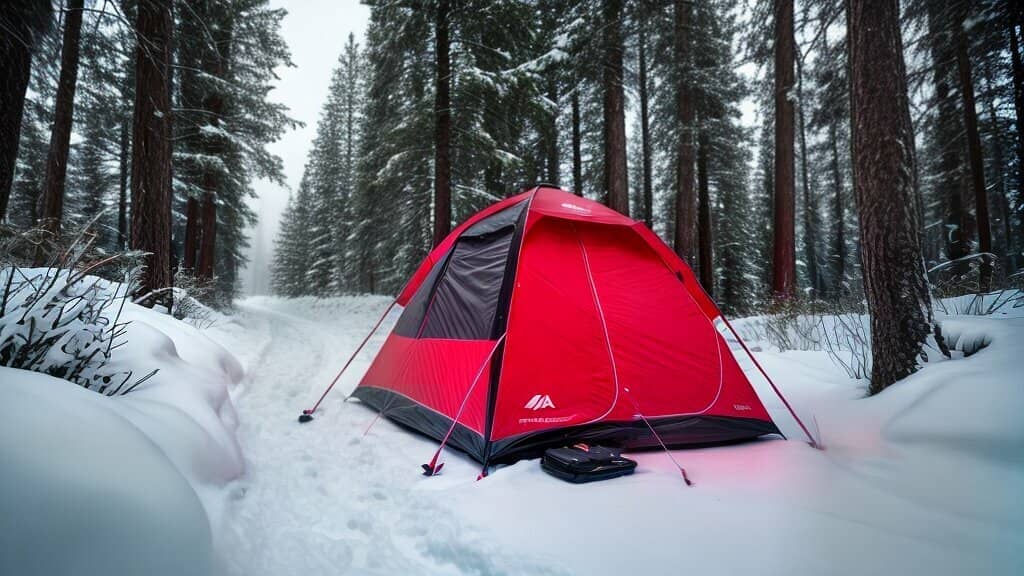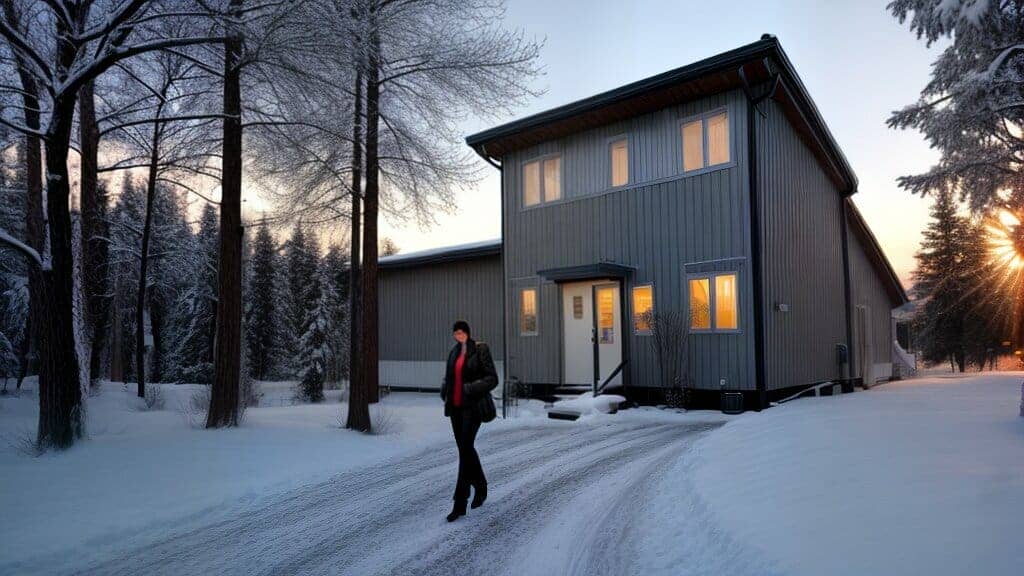With the arrival of winter, many people believe that the risk of contracting Lyme Disease diminishes with the cold temperatures. However, this is not true as ticks are still active at temperatures as low as 32°F and can survive throughout the winter. Lyme Disease is a bacterial infection transmitted to humans through the bite of infected ticks. The disease can cause debilitating symptoms if left untreated, making it essential to understand the associated risks, detection methods, and preventive measures, especially in colder regions.
Key Takeaways
- Lyme Disease can occur in cold climates as ticks can remain active and transmit the disease throughout the year
- Early detection, understanding the risks, and implementing preventive measures are critical
- Ticks and Lyme Disease are not solely restricted to wooded areas, but can be found in urban and suburban areas too
Understanding Lyme Disease and its Transmission
Lyme Disease is a bacterial infection caused by the corkscrew-shaped bacterium Borrelia burgdorferi, which is transmitted through the bite of infected black-legged deer ticks. These ticks are commonly found in wooded and grassy environments and can be active throughout the year, including in colder climates.
When an infected tick bites a human, it can transmit the bacterium through its saliva, and the longer the tick remains attached, the higher the risk of transmission. In colder climates, ticks may be less active during the winter months, but they can still be active during warmer winter days or in indoor environments such as sheds or barns with livestock.
Challenges and Risks Associated with Lyme Disease in Colder Climates
Colder climates pose specific challenges and risks for Lyme Disease. The extended tick activity season due to warmer winter days may increase the likelihood of transmission. Additionally, snow cover can make it difficult to spot ticks on clothing or skin, further delaying detection and treatment.
Furthermore, the symptoms of Lyme Disease can be more difficult to recognize in colder climates due to similarities with other cold-weather illnesses, such as the flu. This can lead to delayed diagnosis and treatment, which can result in more severe and long-lasting symptoms.
Understanding the transmission and risks associated with Lyme Disease is crucial in managing the disease in colder climates. Early detection and treatment are essential for successfully managing the disease and reducing the risk of long-term complications.

“Colder climates pose specific challenges and risks for Lyme Disease. The extended tick activity season due to warmer winter days may increase the likelihood of transmission.”
Recognizing Symptoms in Cold Climates
Lyme Disease can be difficult to diagnose due to its non-specific symptoms, which can vary from person to person. However, recognizing the symptoms of Lyme Disease in cold climates is crucial for early detection and treatment.
Common Symptoms of Lyme Disease
The common symptoms of Lyme Disease include fever, headache, fatigue, muscle aches, and joint pain. In some cases, a characteristic “bullseye” rash may also be present. However, not all individuals with Lyme Disease will exhibit this rash.
In colder climates, symptoms may be more difficult to recognize as individuals may attribute their symptoms to the seasonal flu or common cold. Therefore, it is important to be aware of any tick bites or exposure to tick-infested areas as a potential cause for these symptoms.

Other possible symptoms of Lyme Disease include neurological problems such as numbness, tingling, or facial paralysis. In rare cases, Lyme Disease can also cause heart problems or eye inflammation. If these symptoms arise, it is important to seek medical attention immediately.
It is important to note that Lyme Disease can progress to more serious stages if left untreated. Therefore, individuals should seek medical attention if they experience any of the aforementioned symptoms, especially if they have recently spent time in a tick-infested area.
Prevalence of Lyme Disease in Cold Areas
Lyme Disease is known to be prevalent in regions with a warmer climate, but recent studies have shown that it is also a significant concern for individuals living in colder areas. In fact, cases of Lyme Disease have been reported in all 50 states, with some of the highest rates of infection occurring in the Northeast and Upper Midwest regions of the US.
A study by the Centers for Disease Control and Prevention (CDC) found that the incidence of Lyme Disease in colder regions has been steadily increasing over the past few decades. This is likely due to a combination of factors, including changes in climate patterns that have led to longer tick seasons, as well as an increase in outdoor activities in these areas.
| Region | Reported Cases |
|---|---|
| Northeast | 72,270 |
| Mid-Atlantic | 54,815 |
| Upper Midwest | 15,210 |
According to the CDC, the number of reported cases of Lyme Disease in colder areas has increased by over 300% since the 1990s. This highlights the importance of taking proactive measures to prevent the spread of Lyme Disease in these regions.

To effectively prevent Lyme Disease in colder areas, it is important to understand the unique risks and challenges associated with these regions. This includes implementing environmental modifications to reduce tick habitats, promoting awareness and education, and using protective measures such as tick repellents and wearing appropriate clothing.
By taking these precautions, individuals can reduce their risk of contracting Lyme Disease and protect themselves and their families from this potentially debilitating condition.
Risks and Complications in Cold Climates
Living in colder climates can pose unique risks and complications for individuals with Lyme Disease. One significant concern is the extended tick activity season, which can last longer in colder areas due to snow cover protecting ticks from freezing temperatures. This longer season increases the potential for tick bites and subsequent Lyme Disease infections.
Furthermore, cold weather can delay detection and diagnosis of Lyme Disease. In colder climates, individuals may not spend as much time outdoors during the winter months, which can cause them to overlook symptoms or attribute them to other illnesses. Additionally, the physical symptoms of Lyme Disease, such as joint pain, can be mistaken for typical cold weather discomforts.
It is crucial for individuals in colder climates to remain cautious and proactive in their approach to managing Lyme Disease. This includes taking preventative measures and seeking medical attention as soon as symptoms arise.

“The longer tick activity season in colder climates increases the potential for tick bites and Lyme Disease infections.”
Preventive Measures for Cold Climate Lyme Disease
Preventing Lyme disease in chilly regions is crucial since it is often challenging to diagnose and treat. Below are practical tips and strategies for preventing Lyme disease in cold climates:
| Tips | Description |
|---|---|
| Wear protective clothing | Dress in light-colored clothing with long sleeves and pants to make ticks visible. Tuck pants into socks or boots to prevent ticks from crawling up your legs. |
| Use repellents | Apply insect repellents containing DEET, picaridin, or oil of lemon eucalyptus on exposed skin and clothing. |
| Perform thorough tick checks | Check your entire body, including the scalp, for ticks after spending time outdoors. Pay attention to hard-to-see areas, such as the groin, armpits, and behind the knees. |
| Modify your landscape | Reduce tick habitats by keeping your lawn short, removing leaf litter, and creating a barrier between your lawn and woods. |
It’s essential to keep in mind that prevention is key when it comes to managing Lyme disease in cold climates. By taking these precautions, you can significantly reduce your risk of being infected.

Preventive Measures for Cold Climate Lyme Disease
“Wear protective clothing, use repellents, perform thorough tick checks, and modify your landscape to reduce tick habitats.”
You can also contact your local health department or a pest control expert to learn about tick control methods in your area. These strategies can help minimize your exposure to ticks and tick-borne diseases and protect yourself and your family.
Holistic Treatments for Lyme Disease at Oasis Medical Institute
Oasis Medical Institute in Tijuana, MX offers an integrative approach to treating Lyme Disease, with a particular focus on holistic treatments. Medical Director Dr. Francisco Contreras MD oversees a team of medical professionals who provide personalized treatment plans to help individuals manage their symptoms and improve their overall wellness.
The holistic treatments available at Oasis Medical Institute include:
| Treatment | Description |
|---|---|
| Bio-oxidative Therapy | A treatment that involves introducing oxygen and ozone into the body to help fight infections and improve immune function. |
| Hyperthermia Therapy | A non-invasive treatment that uses heat to stimulate the immune system and improve circulation. |
| Acupuncture | A traditional Chinese medicine practice that involves inserting thin needles into specific points on the body to help manage pain and stress. |
| Herbal Medicine | A natural approach that uses herbs and supplements to support the immune system and alleviate symptoms. |
Through these holistic treatments, individuals with Lyme Disease can experience relief from their symptoms while also improving their overall health and wellbeing. The integrative approach at Oasis Medical Institute recognizes the connection between the mind, body, and spirit, and aims to promote healing on all levels.
If you are interested in pursuing holistic treatments for Lyme Disease, consider booking a consultation with Oasis Medical Institute. Call 866-868-1992 to learn more about their Lyme Disease treatment program.

Detection and Diagnosis Methods
Lyme Disease is notoriously difficult to detect and diagnose, especially in colder climates where symptoms may be masked by other common illnesses. However, early detection is crucial for successful treatment and management of the disease.
Doctors may use a combination of tests to diagnose Lyme Disease, including:
| Test | Description |
|---|---|
| ELISA Test | A blood test that looks for antibodies to the bacteria that causes Lyme Disease |
| Western Blot Test | A more specific blood test that confirms the presence of antibodies to the Lyme Disease bacteria |
| PCR Test | A test that looks for the DNA of the bacteria in blood or tissue samples |
It’s important to note that these tests may not always be reliable, and false negatives can occur. If a patient continues to exhibit symptoms, even with negative test results, doctors may continue to monitor and treat for Lyme Disease.
Clinical Diagnosis
In some cases, doctors may diagnose Lyme Disease based on a patient’s symptoms and history of tick exposure, even without positive test results. This is known as a clinical diagnosis and is especially common in areas where Lyme Disease is prevalent.
Being observant of symptoms and seeking medical attention as soon as possible is key in detecting and managing Lyme Disease.

Traditional Medical Treatments for Lyme Disease
Antibiotics are the most common traditional medical treatment for Lyme Disease. Treatment duration, dosage, and choice of antibiotics may vary based on the stage of the disease and the patient’s medical history and individual health. Early Lyme Disease treatment typically involves a 14 to 21-day course of antibiotics, while late-stage Lyme Disease may require a more prolonged treatment course, up to several months.
For patients with Lyme Disease-related arthritis or other nervous system complications, intravenous (IV) antibiotics may be prescribed for a more aggressive treatment approach. Nevertheless, the use of antibiotics in treating Lyme Disease has been a source of controversy. Critics argue that widespread use of antibiotics can contribute to antibiotic-resistant strains of bacteria.
Therefore, alternative medical treatments have emerged as a way to complement traditional treatments or replace them altogether. These treatments include herbal remedies, homeopathy, and ozone therapy. More information on these alternative treatments can be found on the Holistic Treatments for Lyme Disease at Oasis Medical Institute section below.
| Pros of Traditional Medical Treatments | Cons of Traditional Medical Treatments |
|---|---|
|
|
It is necessary to consult a healthcare professional to discuss treatment options, the risks and benefits of treatment, and the appropriate course of action based on individual medical needs and history.

Lifestyle Modifications for Lyme Disease Management
Living with Lyme Disease in colder climates can present unique challenges when managing symptoms. However, making certain lifestyle modifications can help individuals cope with these challenges and improve their overall well-being.
1. Eat a Healthy Diet
Eating a nutritious diet is essential for maintaining a healthy immune system and managing symptoms. Focus on consuming a variety of fruits, vegetables, lean proteins, and whole grains. Avoid processed and sugary foods as they can exacerbate inflammation and other Lyme Disease symptoms. You can also consult with a nutritionist to create a personalized diet plan.
2. Incorporate Exercise
Regular exercise can help improve energy levels and relieve joint pain associated with Lyme Disease. Start with light exercises like walking or yoga and gradually increase intensity over time. However, be mindful of fatigue and rest when needed.
3. Manage Stress
Living with Lyme Disease can be stressful, and stress can worsen symptoms. Incorporate stress-reducing techniques such as meditation, deep breathing, or therapy to manage stress levels and improve overall well-being.
4. Get Adequate Rest
Adequate rest is essential for Lyme Disease management. Ensure you get at least 7-8 hours of sleep each night, and take short naps during the day if needed. Try to maintain a consistent sleep schedule.
5. Seek Support
Living with a chronic illness can be challenging, and it’s important to seek emotional support. Join a support group, connect with loved ones, or consider speaking with a therapist to manage stress and improve overall well-being.

“The lifestyle modifications discussed in this section can help individuals living with Lyme Disease in colder climates cope with symptoms and improve their overall well-being,” said Dr. Francisco Contreras MD, medical director of Oasis Medical Institute in Tijuana, MX.
Tips for Dealing with Lyme Disease in Cold Conditions
Living with Lyme Disease in cold conditions can be challenging, but there are ways to cope with the symptoms and manage the disease. Here are some tips:
- Dress appropriately: Wear warm clothing, including long sleeves and pants, to minimize skin exposure and tick bites. Tuck pants into socks and wear a hat.
- Perform tick checks: Check yourself and your pets for ticks regularly, especially after spending time outdoors. Remove any ticks immediately.
- Manage symptoms: Keep track of your symptoms and take prescribed medications as directed. Rest when needed and pace yourself throughout the day to conserve energy.
- Practice stress management: Stress can worsen symptoms, so it’s important to manage stress levels. Try relaxation techniques like meditation, yoga, or deep breathing exercises.
- Eat a healthy diet: A balanced diet can help boost the immune system and manage symptoms. Avoid processed foods and sugar, and focus on nutrient-dense, whole foods.
- Stay active: Regular exercise can help manage symptoms and improve overall health. Choose low-impact activities like walking, yoga, or swimming.
- Seek support: Living with Lyme Disease can be isolating, but there are support groups and online communities available. Connect with others who understand what you’re going through.
By taking these precautions and making lifestyle modifications, individuals with Lyme Disease in cold climates can better manage their symptoms and live a fulfilling life.

Risks and Complications in Cold Climates
Living in cold climates poses unique challenges and risks for individuals with Lyme Disease. Extended tick activity seasons and delayed detection due to weather conditions can increase the likelihood of contracting Lyme Disease and exacerbating symptoms.
According to the Centers for Disease Control and Prevention (CDC), individuals in the northeastern and upper midwestern areas of the United States are at the highest risk for Lyme Disease.
The harsh winter conditions in these regions can prompt ticks to seek alternative hosts, such as small rodents or birds, increasing their chance of carrying Lyme Disease. Additionally, snow cover can make it challenging to detect ticks and prevent bites.
Individuals with Lyme Disease in cold climates also face the risk of potential complications. Hypothermia and frostbite are increased risks for individuals with Lyme Disease who may have reduced mobility or circulation. The cold weather can also affect the immune system, making it more difficult to fight off infections.

Avoiding outdoor activities or applying protective clothing and insect repellent can reduce the risk of contracting Lyme Disease in cold climates. Regular tick checks and research on tick habitats in the local environment can also aid in prevention.
Risks and Resources for Lyme Disease in Cold Climates
Living with Lyme Disease in colder climates brings its own set of challenges and risks. The extended tick activity season and the potential for delayed diagnosis due to weather conditions can exacerbate the effects of the disease. However, there are precautions individuals can take to minimize their risk of contracting Lyme Disease and resources available for support.
Cold Climate Precautions for Lyme Disease
To reduce the risk of contracting Lyme Disease in colder climates, individuals should take additional precautions. According to the Centers for Disease Control and Prevention (CDC), individuals should:
| Tick Control | Landscaping Practices | Pet Protection |
|---|---|---|
|
|
|
Additionally, individuals should avoid walking through tick habitats, wear protective clothing, use tick repellent, and perform thorough tick checks after spending time outdoors.
Support and Resources for Lyme Disease in Cold Climates
Living with Lyme Disease can be challenging, and support is available for those who need it. Online communities and support groups can offer a place for individuals to connect with others who understand their experiences. The following organizations provide resources for those affected by Lyme Disease:
- The Lyme Disease Association
- The International Lyme and Associated Diseases Society (ILADS)
- The National Institute of Allergy and Infectious Diseases (NIAID)
These organizations offer educational materials, support groups, and conferences to provide additional information and resources for those living with Lyme Disease.

Book a Consultation for Lyme Disease Treatment at Oasis Medical Institute
For individuals diagnosed with Lyme Disease, seeking proper medical treatment is crucial for effective management and recovery. At Oasis Medical Institute in Tijuana, MX, medical director Dr. Francisco Contreras MD offers an integrative approach to Lyme Disease treatment, including holistic therapies and traditional medical techniques.
To book a consultation for the Lyme Disease treatment program at Oasis Medical Institute, individuals can call 866-868-1992. The knowledgeable and compassionate team at Oasis Medical Institute is dedicated to helping individuals manage their Lyme Disease symptoms and improve their overall quality of life.

Contact Oasis Medical Institute today to start your journey towards Lyme Disease management and recovery.
Conclusion
In colder climates, Lyme Disease poses a significant risk to individuals who spend time outdoors. Early detection, understanding the risks, and taking preventative measures are crucial for managing this disease.
It is essential to recognize the signs and symptoms of Lyme Disease and seek medical attention for accurate diagnosis and effective treatment. Traditional medical treatments, lifestyle modifications, and holistic approaches can all play a role in managing the disease in cold climates.
Individuals living in cold climates should take precautions to minimize their risk of contracting Lyme Disease, such as tick control, landscaping practices, and pet protection. Seeking support from resources and organizations can also be beneficial for those living with Lyme Disease in cold conditions.
For those seeking effective treatment, Oasis Medical Institute provides an integrative approach to treating Lyme Disease, including holistic treatments. To book a consultation for Lyme Disease treatment program, individuals can call 866-868-1992.
Overall, being informed and proactive about Lyme Disease in colder climates can lead to better management and prevention of this potentially debilitating disease.
FAQ
Q: What is Lyme Disease and how is it transmitted?
A: Lyme Disease is an infectious disease caused by the bacterium Borrelia burgdorferi and is primarily transmitted to humans through the bite of infected black-legged ticks.
Q: What are the common symptoms of Lyme Disease in cold climates?
A: Common symptoms of Lyme Disease in cold climates include fatigue, fever, headache, muscle and joint aches, swollen lymph nodes, and a characteristic skin rash called erythema migrans.
Q: How prevalent is Lyme Disease in cold areas?
A: Lyme Disease has been reported in all 50 states in the United States, but it is more prevalent in certain regions, especially those with colder climates where ticks thrive.
Q: What are the risks and complications of Lyme Disease in cold climates?
A: Risks and complications of Lyme Disease in cold climates include extended tick activity seasons, delayed detection due to weather conditions, and an increased risk of developing chronic Lyme Disease.
Q: What preventive measures can be taken for Lyme Disease in cold climates?
A: Preventive measures for Lyme Disease in cold climates include wearing protective clothing, using repellents, performing thorough tick checks, and modifying the environment to discourage tick habitats.
Q: What holistic treatments are available for Lyme Disease at Oasis Medical Institute?
A: Oasis Medical Institute offers a range of holistic treatments for Lyme Disease, focusing on integrative approaches. Medical director Dr. Francisco Contreras MD oversees these treatments.
Q: How is Lyme Disease in cold climates detected and diagnosed?
A: Lyme Disease in cold climates can be detected and diagnosed through various methods and tests, including blood tests, clinical evaluation, and examination of symptoms.
Q: What are the traditional medical treatments for Lyme Disease in cold climates?
A: Traditional medical treatments for Lyme Disease in cold climates often involve the use of antibiotics and other medications prescribed by healthcare professionals to manage the disease.
Q: What lifestyle modifications can help in managing Lyme Disease in colder climates?
A: Lifestyle modifications such as maintaining a healthy diet, regular exercise, stress management, and getting adequate rest can help individuals manage Lyme Disease in colder climates.
Q: What are some tips for dealing with Lyme Disease in cold conditions?
A: Some tips for dealing with Lyme Disease in cold conditions include coping with symptoms, managing energy levels, and seeking appropriate support from healthcare professionals and support groups.
Q: What precautions should individuals take for Lyme Disease in cold climates?
A: Individuals living in cold climates should take additional precautions, including tick control, landscaping practices, and protecting pets, to minimize the risk of contracting Lyme Disease.
Q: Are there support and resources available for Lyme Disease in cold climates?
A: Yes, there are support groups, online communities, and resources available for individuals living with Lyme Disease in cold climates. Various organizations and websites provide valuable information and support.
Q: How can one book a consultation for Lyme Disease treatment at Oasis Medical Institute?
A: To book a consultation for Lyme Disease treatment at Oasis Medical Institute, please call 866-868-1992. Medical director Dr. Francisco Contreras MD oversees the treatment program.
Dr. Francisco Contreras, MD is a renowned integrative medical physician with over 20 years of dedicated experience in the field of integrative medicine. As the Medical Director of the Oasis of Hope Hospital in Tijuana, Mexico, he has pioneered innovative treatments and integrative approaches that have been recognized globally for the treatment of cancer, Lyme Disease, Mold Toxicity, and chronic disease using alternative treatment modalities. Dr. Contreras holds a medical degree from the Autonomous University of Mexico in Toluca, and speciality in surgical oncology from the University of Vienna in Austria.
Under his visionary leadership, the Oasis of Hope Hospital has emerged as a leading institution, renowned for its innovative treatments and patient-centric approach for treating cancer, Lyme Disease, Mold Toxicity, Long-Haul COVID, and chronic disease. The hospital, under Dr. Contreras's guidance, has successfully treated thousands of patients, many of whom traveled from different parts of the world, seeking the unique and compassionate care the institution offers.
Dr. Contreras has contributed to numerous research papers, articles, and medical journals, solidifying his expertise in the realm of integrative medicine. His commitment to patient care and evidence-based treatments has earned him a reputation for trustworthiness and excellence. Dr. Contreras is frequently invited to speak at international conferences and has been featured on CNN, WMAR2 News, KGUN9 News, Tyent USA, and various others for his groundbreaking work. His dedication to the medical community and his patients is unwavering, making him a leading authority in the field.
Contreras has authored and co-authored several books concerning integrative therapy, cancer, Lyme Disease and heart disease prevention and chronic illness, including "The Art Science of Undermining Cancer", "The Art & Science of Undermining Cancer: Strategies to Slow, Control, Reverse", "Look Younger, Live Longer: 10 Steps to Reverse Aging and Live a Vibrant Life", "The Coming Cancer Cure Your Guide to effective alternative, conventional and integrative therapies", "Hope Medicine & Healing", "Health in the 21st Century: Will Doctors Survive?", "Healthy Heart: An alternative guide to a healthy heart", “The Hope of Living Cancer Free”, “Hope Of Living Long And Well: 10 Steps to look younger, feel better, live longer” “Fighting Cancer 20 Different Ways”, "50 Critical Cancer Answers: Your Personal Battle Plan for Beating Cancer", "To Beat . . . Or Not to Beat?", and “Dismantling Cancer.”






















